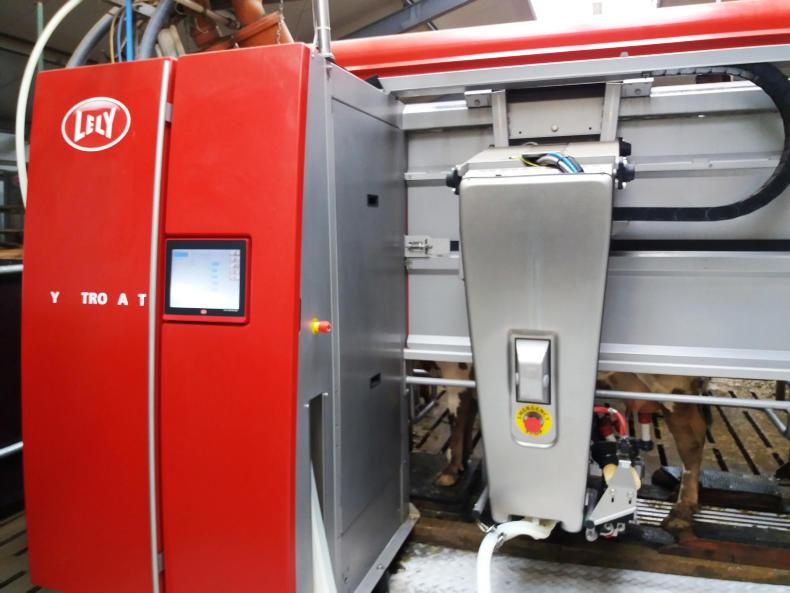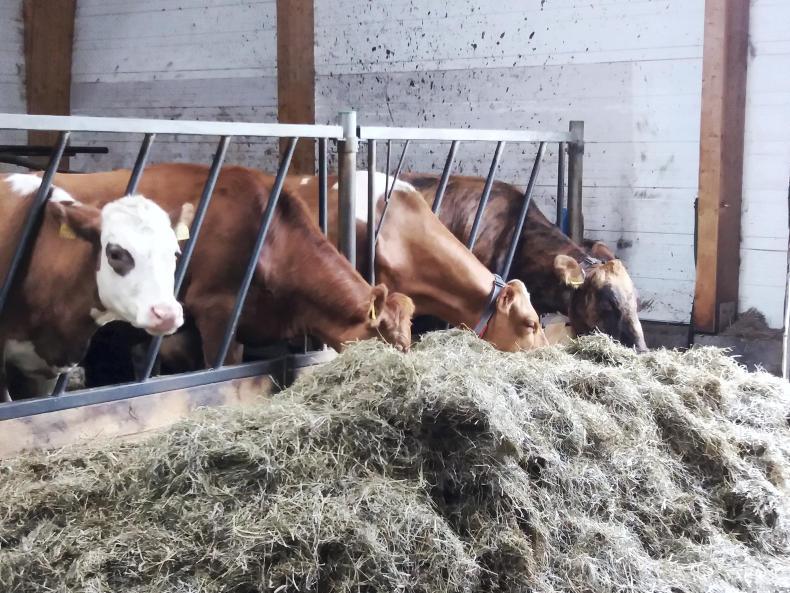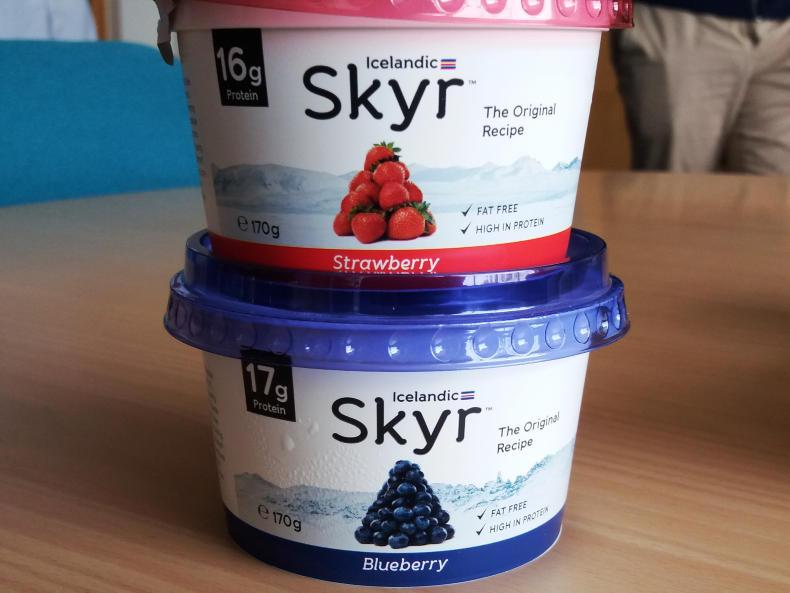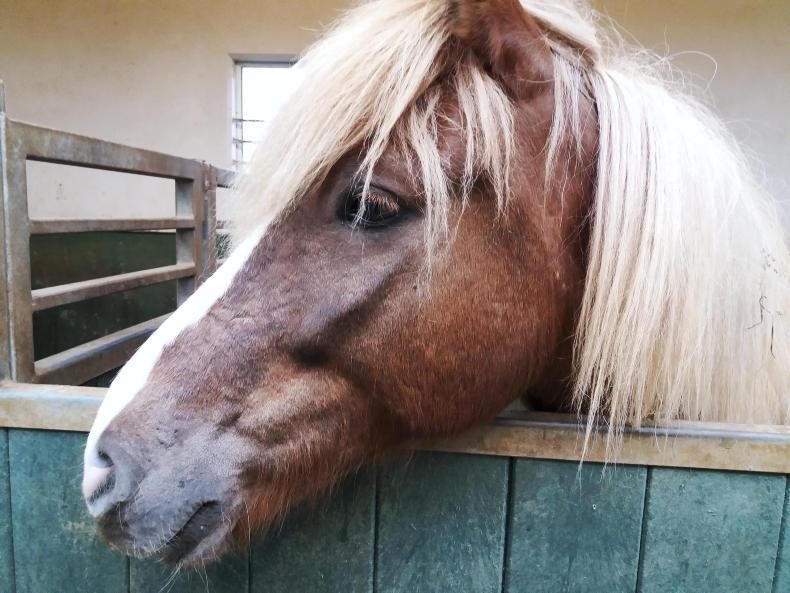Last week, the Irish Farmers Journal took part in a study tour of Iceland, hosted by Celtic Sea Minerals and AB Vista.
As part of a group of journalists and industry colleagues, we got a taste of what its like to farm in Iceland.
1. The Icelandic cattle breed
The Icelandic cow is a small, polled breed, and DNA studies have shown that the breed is similar to that of cows in Scandinavia – which would make sense, given that the Vikings brought cows to Iceland when they settled on the island.
New research has shown that the Vikings may also have brought some French and British cattle breeds along with them. In total, there are approximately 74,500 cattle, for beef and dairy production, in Iceland.
The breed comes in a range of colours, with six basic colours and more than 100 colour schemes. The most common colours are red, brown and black.
2. Milking robots are big
In a country where fire and ice exist alongside each other, there is just under 600 dairy farmers – 42% of them are using robots to milk Iceland’s 26,000 dairy cows.
The majority of dairy farmers are based in the south of the island, with other dairy farmers dotted around the coast.
Over 90% of farmers supply MS Dairies, which is headquartered in Reykjavik.

Some 42% of dairy farmers in Iceland use milking robots.
3. Live cattle imports banned
Live cattle are banned from being imported for use in Iceland’s dairy herd and beef herds. Certain types of bull semen are allowed in for the beef herd, such as Galloway cattle.
As a result of the breed being isolated from others for over 1,000 years, disease levels are low in Iceland’s cattle. The country is classified as both TB-free and brucellosis-free.
AI is the main breeding method in the country, with semen sourced from around the country. Inbreeding is kept to as minimum a degree as possible.

Live cattle imports for the dairy herd are banned.
4. Skyr
Skyr, a thick, creamy yoghurt is produced in Iceland and is unique to the country. It has been a natural part of the Icelandic diet since the Vikings settled.
Skyr is made from skim milk and it is high in protein and naturally fat free.
MS Dairies produces the yoghurt, which is sold in Finland, Ireland and the US. Some 10% of the company’s turnover comes from exporting products such as Skyr.

Unique to Iceland is Skyr yoghurt, which has been produced in the country for hundreds of years.
5. Horse farming
Horse farming is also big in Iceland. The Icelandic horse, native to the country, is a ‘small’ breed, with stallions averaging between 13-15 hands.
Much like the cattle herd, importation of horses is forbidden in the country, leaving the breed to be relatively disease free.
Horses that are exported or go to competitions outside of the country are not allowed to return.
It has five different gaits: a walk, a trot, a canter, a tölt (where one foot is always touching the ground) and a gallop.

Icelandic horses are native to the country and, like the cattle, are a small breed.
6. Seaweed harvesting for animal feed
Perhaps a different type of farming compared with what we’re used to in Ireland, in the western fjords of Iceland dead seaweed is harvested and processed into an additive for animal feed which is used in Ireland.
Irish company Celtic Sea Minerals is behind the product and its plant in the small isolated village of Bíldudalur employs 18 people.
Essentially, red seaweed in the clear, unpolluted waters off the village absorbs a range of minerals, which calcify the tips of the plant. It then breaks off and deposits away from the live plant, allowing for it to be harvested.
It then goes through a process with the end product being manufactured as Acidbuf, which buffers the rumen of animals, including cattle, helping prevent acidosis in the rumen.
The land of the midnight sun and dairy expansion
Last week, the Irish Farmers Journal took part in a study tour of Iceland, hosted by Celtic Sea Minerals and AB Vista.
As part of a group of journalists and industry colleagues, we got a taste of what its like to farm in Iceland.
1. The Icelandic cattle breed
The Icelandic cow is a small, polled breed, and DNA studies have shown that the breed is similar to that of cows in Scandinavia – which would make sense, given that the Vikings brought cows to Iceland when they settled on the island.
New research has shown that the Vikings may also have brought some French and British cattle breeds along with them. In total, there are approximately 74,500 cattle, for beef and dairy production, in Iceland.
The breed comes in a range of colours, with six basic colours and more than 100 colour schemes. The most common colours are red, brown and black.
2. Milking robots are big
In a country where fire and ice exist alongside each other, there is just under 600 dairy farmers – 42% of them are using robots to milk Iceland’s 26,000 dairy cows.
The majority of dairy farmers are based in the south of the island, with other dairy farmers dotted around the coast.
Over 90% of farmers supply MS Dairies, which is headquartered in Reykjavik.

Some 42% of dairy farmers in Iceland use milking robots.
3. Live cattle imports banned
Live cattle are banned from being imported for use in Iceland’s dairy herd and beef herds. Certain types of bull semen are allowed in for the beef herd, such as Galloway cattle.
As a result of the breed being isolated from others for over 1,000 years, disease levels are low in Iceland’s cattle. The country is classified as both TB-free and brucellosis-free.
AI is the main breeding method in the country, with semen sourced from around the country. Inbreeding is kept to as minimum a degree as possible.

Live cattle imports for the dairy herd are banned.
4. Skyr
Skyr, a thick, creamy yoghurt is produced in Iceland and is unique to the country. It has been a natural part of the Icelandic diet since the Vikings settled.
Skyr is made from skim milk and it is high in protein and naturally fat free.
MS Dairies produces the yoghurt, which is sold in Finland, Ireland and the US. Some 10% of the company’s turnover comes from exporting products such as Skyr.

Unique to Iceland is Skyr yoghurt, which has been produced in the country for hundreds of years.
5. Horse farming
Horse farming is also big in Iceland. The Icelandic horse, native to the country, is a ‘small’ breed, with stallions averaging between 13-15 hands.
Much like the cattle herd, importation of horses is forbidden in the country, leaving the breed to be relatively disease free.
Horses that are exported or go to competitions outside of the country are not allowed to return.
It has five different gaits: a walk, a trot, a canter, a tölt (where one foot is always touching the ground) and a gallop.

Icelandic horses are native to the country and, like the cattle, are a small breed.
6. Seaweed harvesting for animal feed
Perhaps a different type of farming compared with what we’re used to in Ireland, in the western fjords of Iceland dead seaweed is harvested and processed into an additive for animal feed which is used in Ireland.
Irish company Celtic Sea Minerals is behind the product and its plant in the small isolated village of Bíldudalur employs 18 people.
Essentially, red seaweed in the clear, unpolluted waters off the village absorbs a range of minerals, which calcify the tips of the plant. It then breaks off and deposits away from the live plant, allowing for it to be harvested.
It then goes through a process with the end product being manufactured as Acidbuf, which buffers the rumen of animals, including cattle, helping prevent acidosis in the rumen.
The land of the midnight sun and dairy expansion










 This is a subscriber-only article
This is a subscriber-only article















SHARING OPTIONS: